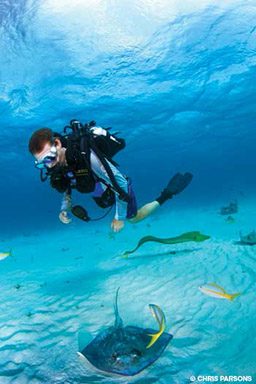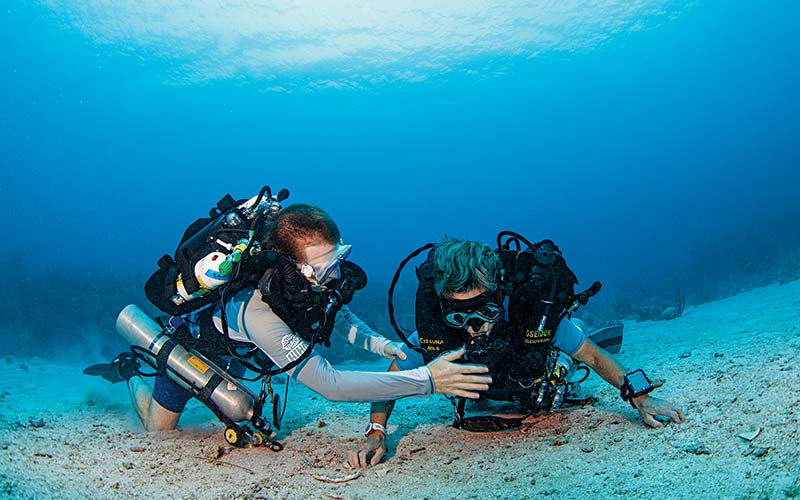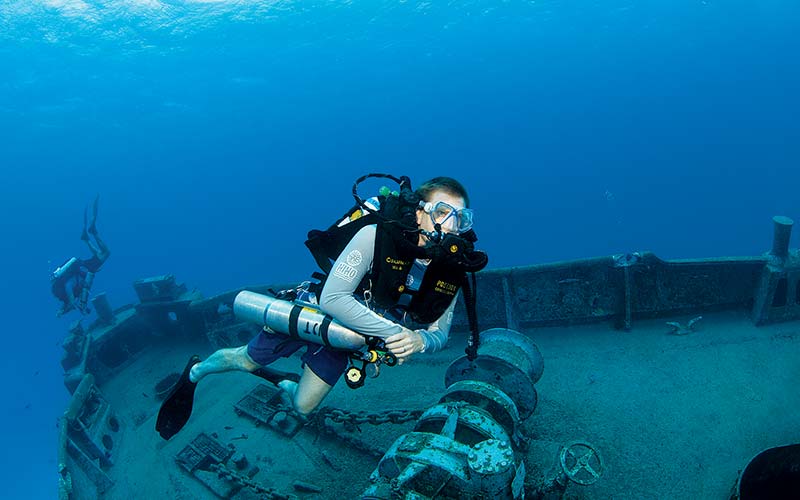
It was dinner time at Divetech. As I walked past the kitchen, I noticed two red lights blinking on the side of the oven. Before I realized what I was doing I had raised my hand to my mouth and tilted an imaginary switch away from my face while reciting to myself, “If you encounter a problem, bail out to open-circuit scuba” — the mantra of the recreational rebreather student.
I hadn’t even gotten my hands on a rebreather yet, but I’d been doing a lot of reading. I had studied my training manual for weeks, and on the flight to Grand Cayman I carefully read every page of the owner’s manual for the Poseidon MKVI, the rebreather I would be learning to dive during Tek Week 2012. Once I actually started my class I learned that checking my console was a better response to a warning light, but I was still reassured by my heightened awareness.
I’ve been diving for 20 years, but I have yet to venture into technical diving. With the growing popularity of recreational rebreathers, though, I saw an opportunity to get a glimpse into that world.
Relearning Buoyancy Control
Apparently, in all my years as a diver I’ve been using my breath to make fine adjustments to my buoyancy. I know this because on my first day as a rebreather diver my buoyancy control went to hell. The main difference is this: When using a closed-circuit rebreather (CCR), breathing doesn’t change the amount of gas in the system; it simply moves a volume of gas back and forth between your lungs and the unit’s counterlungs (gas reservoirs). Thus, efforts to fine tune buoyancy with well-timed inhalations led me to crash awkwardly into the bottom of the pool on several occasions.
In addition to relearning buoyancy control, I had to get over my desire to feel the familiar flood of cold, dry air that a second-stage regulator delivers. I’ve always heard divers talk about breathing normally while open-circuit scuba diving, but breathing with a rebreather is much more like normal topside breathing than open-circuit breathing is. It’s so similar to normal breathing, in fact, that it felt very strange to do it underwater.

Elegant Design
A rebreather’s hoses, mouthpiece and counterlungs are known as the loop. The beauty of recreational rebreathers is their ability to make sure the gas in the loop is always optimized for breathability. They do this automatically, detecting the percentage of oxygen in the circulating gas, accounting for depth and adding oxygen or air to the mix as needed. A canister of carbon-dioxide-absorbing scrubber removes CO2 from the gas. All this delivers two primary benefits to recreational divers: long dive times and the quiet absence of bubbles.
Rebreathers combine stunningly complex components with very simple, yet brilliantly implemented ones. On the complex side, the battery of the unit I used can get 30 hours out of a charge, has its own onboard computer (which stores dive-log data and decompression status separate from the unit’s main computer) and even houses LEDs and a speaker that broadcast distress signals if the computer detects any problems. On the simple side, rebreathers’ mushroom valves are a pair of thin, rubbery discs that sit within the hoses on either side of the diver’s mouth. When the diver inhales, the valve on the side of the freshly scrubbed and properly oxygenated gas is pulled open, while the one leading toward the scrubber is pushed closed. When you exhale, the flexible discs blow the other way. These two thin discs are all it takes to keep the air moving through the loop in the right direction.

A recreational rebreather is so thoroughly automated that I had some initial trepidation about trusting my life to a computer. “You do it every time you fly,” pointed out my instructor, Georgia Hausserman, who was a pilot. I also appreciated the perspective offered by another grinning rebreather diver, who said, “Think of it this way — who would you rather have making these calculations: Richard Pyle and Bill Stone or YOU?” Perhaps most reassuring was a comment made by another diver: “Don’t think of your rebreather’s computer as a PC; think of it as a calculator.” That worked for me; I’ve wanted to throw my laptop out of a window more than a few times, but I’ve never had a calculator tell me two plus two equals five.
Checklists Save Lives
Learning to use a checklist and conduct a prebreathe (a five-minute test breathe of a rebreather before diving) are essential parts of becoming a rebreather diver. Georgia had seen a man become hypoxic on the surface and nearly die just a few weeks earlier. He had failed to reconnect his oxygen after a predive problem that required him to disassemble and reassemble his unit. If he had done any number of things, including starting his checklist over from the beginning, conducting a proper prebreathe or checking his display, he wouldn’t have come within inches of his life while trying to put on fins in three feet of water. Fortunately, bystanders noticed he wasn’t moving, pulled him out and saved his life. The man had been arguing that checklists don’t work the previous evening at dinner.

Amazing Experiences
When I asked Georgia about her own transition into rebreather diving, she told me she was dragged kicking and screaming but that she now dives more with her rebreather than she ever did with open-circuit scuba. When I asked her why, she said, “Because I expect to have amazing experiences.” One such experience involved an eight-foot hammerhead, which swam up behind her and passed within a few feet. Another involved a whitetip reef shark that circled her three times, while a second whitetip cruised in from out of nowhere to make a close pass.
I’ve only logged a few rebreather dives so far, but I’ve had some memorable interactions, too. A big mutton snapper and I watched each other closely as it swam toward me, gazing intently, before veering off mere inches from my face. Early in my training before I had figured out how to maintain the right amount of gas in my loop, I was watching some jawfish dance above their burrows. Every time I had to vent gas from the loop they shied downward into their holes. When I managed to achieve proper loop volume and stopped making bubbles, they danced like no one was watching.

I heard some unforgettable sounds while diving with the rebreather, too. I watched a parrotfish nibble the reef for minutes on end, and I heard every crunch. Later, I became keenly aware of a rushing roar that seemed to come out of the heavy blueness around me as I hung above a deep pinnacle.
On my last day in Cayman I was happy to get acquainted with the wreck of the USS Kittiwake. The Kittiwake lies in the sand a short distance from the top of a wall, which plunges dramatically into untold depths. Across the sand from the wreck, situated near the top of the wall, massive coral structures rise high off the sand. Swimming along the seafloor through a narrow passage that separated two of these towering reef structures, I emerged from between them at the top of the wall. As I hung there above the void, its allure was tremendous.
“So this is what all those tech divers are going on about,” I thought.
© Alert Diver — Q1 Winter 2013